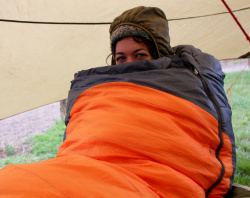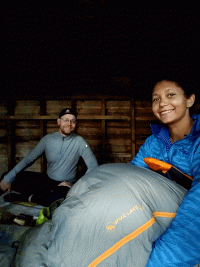News & Updates
Traveling Trainer Tips: Shoulder Season Camping

Guest
-
October 31, 2017

Fayetteville, WV: Fall is gently tapping winter on the shoulder, ushering the new season into the eastern states. We had our first sub-freezing evening a few days ago, waking in the morning to a thin layer of ice on the car. Keeping warm under these conditions requires knowledge and some practice – and as Traveling Trainers sleep outdoors as many as 250 nights in a year, we've got both to spare. Here are our top three tips for making sure you stay warm when you're camping in late fall or early spring.

1. Layer Up
Layering is important in these shoulder months – but the key is to minimize sweating, so that as the temperatures cool, your core temperature doesn't. There are generally three layers to think about: a base layer or next-to-skin garment, a midlayer or insulating layer, and an outer layer. While the outer layer tends to be the least breathable – and the most weather resistant – investing in breathable fabrics for your mid- and base layers, like merino wool from Smartwool, ensures that you have greater control over how warm your core gets and how much you sweat.
2. Down vs. Synthetic
Understanding the benefits and the drawbacks of these mid- or outer layer materials – used as insulation in coats and sleeping bags – will help you make the right decisions for your trip. Down is the warmer of the two options, but loses its insulating abilities when wet. Though technologies like DriDown coatings can help, synthetic insulation is a better choice in potentially wet conditions; though it has less insulating value, it can be a literal lifesaver in wet and hypothermic conditions. Check the weather before you go, and know your own skill level when it comes to keeping your gear dry.
 3. Snuggle In
3. Snuggle In
Once you're camped out and settling in, there are plenty of ways to get warm before bed. As all insulation works by trapping warm air between you and your sleeping bag, heating the inside of your bag is the best way to warm up. Do some jumping jacks or eat a hot meal before getting into your sleeping bag. If you're careful, you could also use a hot water bottle to heat things up. Bring a pot of water close to boiling on your portable Primus stove, then pour the hot water into your Klean Kanteen bottle, close the lid tightly to prevent leaks, and wrap the bottle in a piece of cloth to make sure you're insulated from the heat. Stick the water bottle into your sleeping bag for some lasting warmth. (Be sure not to use a thin plastic bottle, like one-time-use drink bottles, as these will melt with the water's heat.) Lastly, make sure you empty your bladder before you settle in for the night, and if you do have to go in the middle of the night, get up and go – your body prioritizes keeping your bladder warm over keeping the rest of you warm.
The end of fall doesn't have to spell the end of camping season. As we'll be camping well into November, we'll be relying heavily on these tips to keep us warm and cozy – if you've got a great one that we missed, leave us a note in the comments below!

We hope you enjoy your changing seasons, and Enjoy Your World!
–Amanda and Junaid, Team East Central
Leave No Trace's Amanda Jameson and Junaid Dawud are part of the 2017 Subaru/Leave No Trace Traveling Trainer Program that provides free, mobile education to communities across the country. Proud partners of this program include Subaru of America, REI, Eagles Nest Outfitters, Deuter, Thule, Klean Kanteen, and Smartwool.
Let’s protect and enjoy our natural world together
Get the latest in Leave No Trace eNews in your inbox so you can stay informed and involved.
